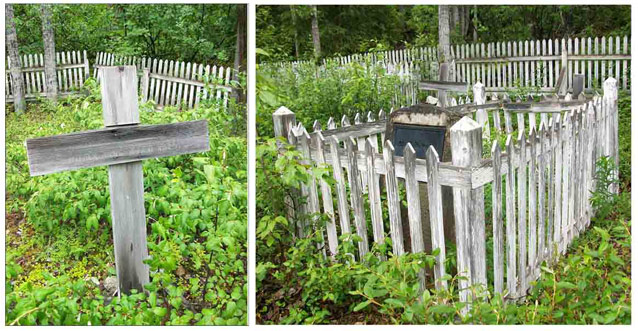In 1908, Edward Donaldson was the first to be buried at Kennecott Cemetery during the early days of settlement at the Kennecott Mill Town. Used for the next thirty years, the cemetery represents a period of life, development, and eventual decline at the Kennecott Mines and Mill Town. The final burial was in 1938, as the Kennecott mining operations closed. The cemetery presents the social history and cultural practices of the remote Alaska mining community.
Grave Structure 11: "OSCAR HANSEN. BORN 1886. DIED FEB. 10. 1921."
Oscar died in a fall in Bonanza Mine. His casket was $10.74. The wooden, inscribed cross that marks the burial stands alongside the markers for other individuals from many countries.


NPS
The Kennecott Cemetery is located a quarter mile south from the Kennecott Mill Town site, within the boundaries of the Kennecott Mines National Historic Landmark in Wrangell-St. Elias National Park and Preserve, Alaska. The cemetery is accessed by an old Wagon Road, which was the primary route to the mill town before the Copper River and Northwestern Railway was completed in 1911.
The Kennecott Cemetery is approximately .25 acres in size and contains fifty grave markers, subterranean structures, fences, and a few small scale features such as metal buckets, a ladder, and a shovel that contribute to its historic character.

NPS
The cemetery is directly related to the historic development of the Kennecott Mines and Mill Town, as it was the main burial ground serving those who lived and worked at Kennecott between 1908 and 1938. Burials began in the early days of the town’s settlement and continued until the mine closed in 1938. It provides information about the social history and cultural practices of a thriving mining town over time.
The population buried at the Kennecott Cemetery represents individuals whose families could not afford to have the body shipped back to their homeland, who did not have any reference contacts, or whose family was living at Kennecott and wanted their deceased to remain nearby.
Those interred at the cemetery often met their end from hazardous endeavors associated with mining at Kennecott. It is also notable that the burials reflect a remarkably diverse population in terms of ethnicity, but the graves are not segregated based on race, religion, age, or gender. The cemetery was an important aspect of the community of Kennecott, and it endures as a social symbol and physical reminder of the people who lived, worked, and died there throughout its history.

NPS
Quick Facts
-
Cultural Landscape Type: Historic Site
-
National Register Significance Level: Local
-
National Register Significance Criteria: A
-
National Historic Landmark
-
World Heritage Site
-
Period of Significance: 1908-1938
Landscape Links
Last updated: May 17, 2019
